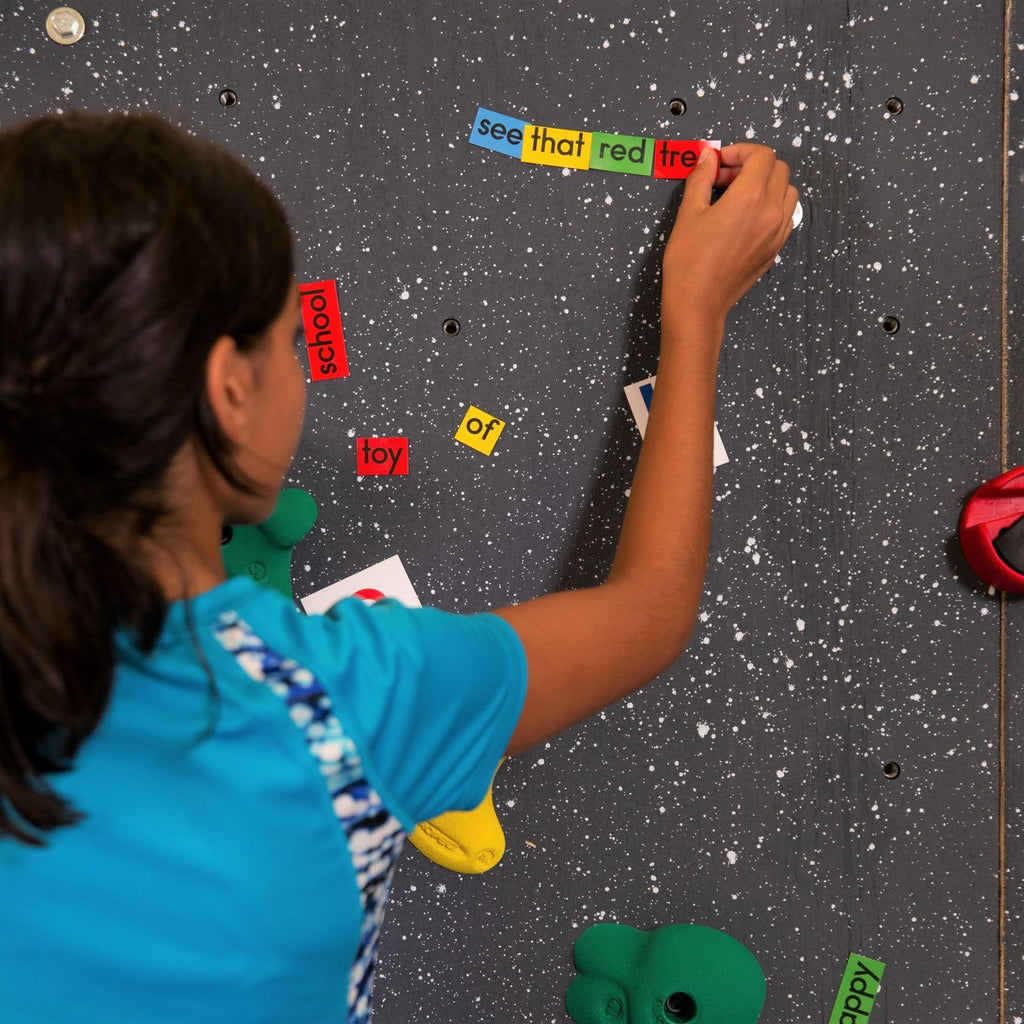
Our Favorite Cross-Curricular Climbing Wall Activities
Many schools are looking for ways to bring more physical activity into the school day beyond physical education classes. Integrating movement with classroom learning is one way to accomplish this. And if you have a Traverse Wall®, we have ideas for how to use it to reinforce literacy and math concepts. Learning while rock climbing? That’s a win-win! Check out our three favorite cross-curricular activities and read our past blog post about sharing the climbing wall with classroom educators.
WORD WARM-UP
Materials needed: Words or letters (magnets or written on notecards or the climbing wall, depending on your climbing wall surface)
Advance Prep: Determine your activity and place words or letters across your Traverse Wall, high and low. How you place them will depend on what type of climbing wall you have. Magnets work well on a Magna® Wall or Discovery® Dry-Erase Wall. Notecards can be taped or tucked behind hand holds if your wall is not cross-curricular.
Grade Level: K & up
Grouping: Whole class
Activity: Depending on age and abilities, have climbers:
- Identify the letters in their names
- Practice the sounds letters make
- Spell words
- Read words
- Create sentences
- Identify what part of speech a word is (noun, verb, adjective, etc.)
- Give the definition of words
- State the synonyms or antonyms of words

FIND FACT FAMILIES
Materials needed: Numbers (magnets or written on notecards or the climbing wall, depending on your climbing wall surface) and chart paper and markers
Advance Prep: Determine what types of fact families you will have climbers identify. Then place numbers that will create those fact families across the climbing wall, high and low. How you place them will depend on what type of climbing wall you have. Magnets work well on a Magna® Wall or Discovery® Dry-Erase Wall. Notecards can be taped or tucked behind hand holds if your wall is not cross-curricular. Mount chart paper near the climbing wall with markers.
Grade Level: 2 & up
Grouping: Whole class
Activity: While traversing the climbing wall, climbers should find and point to numbers that make a fact family and then record them on the chart paper. They repeat this for as long as time permits. Leave some time at the end of the session to review the families recorded on the chart paper and discuss with the group.
Variation: This activity can be conducted as a partner activity on one climbing panel. Once the climber has found a certain number of fact families and recorded them, partners switch roles. Just be sure there are enough numbers on each climbing wall panel.
Teaching Tip: Prior to the activity, review examples of fact families.

PARTS OF SPEECH ROUTE CLIMB
Materials needed: Words (magnets or written on notecards or the climbing wall, depending on your climbing wall surface)
Advance Prep: Choose two or more parts of speech (for example, nouns and verbs) and place those words near hand holds to create climbing routes. Be sure to place a variety of words near most of the hand holds so that climbers must think about which hold they are using to stay on the climbing route. How you place the words will depend on what type of climbing wall you have. Magnets work well on a Magna® Wall or Discovery® Dry-Erase Wall. Notecards can be taped or tucked behind hand holds if your wall is not cross-curricular. Review our past blog post for help with route setting.
Grade Level: 4 & up
Grouping: Whole Class
Activity:
Climbers are challenged to route climbing using only the holds labeled with a certain part of speech. For example, they must climb only using the holds labeled with nouns.
Variations:
- To simplify the activity, have climbers use any foothold and stay on the route only with the holds they use for their hands. This also simplifies the set up since you will not place words low on the climbing wall, only in the middle and higher (where hands would reach).
- A math version of this activity involves placing numbers near hand holds and having climbers climb using only odd/even numbers, multiples of 2, etc.
Teaching Tip: Prior to the activity, review definitions and examples of the parts of speech that will be part of this activity.

Leave a comment